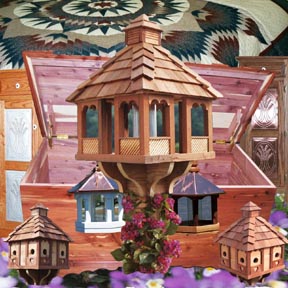
Hand crafted heirlooms made to last a lifetime. |
|
 |
 |
 |
 |
 |
 |
|
 |
 |
 |
|
 |
 |
 |
 |
|
 |
|
Amish Delights™
P.O. Box 2371
West Chester, PA 19380
Telephone: 610-692-7650
Fax: 610-692-2883
E-mail:
AmishDelights@AmishDelights.com |
|
Amish Delights©
Offering the Finest in Hand
Crafted Heirlooms
Welcome
to our Bird and Bat House and Bird Feeder
Frequently Asked Questions Page
A mackerel sky,
The wind will be high;
Then bring in the grain,
Close by there is rain.
from Pennsylvania Dutch Folklore |

©2002 Amish Delights |
-
Are your bird and bat houses and bird feeders truly hand made?
-
Each one of our products is indeed hand made by Amish artisans. This is why we state on our Home Page that no two items are ever exactly alike. In addition, every product we sell is absolutely 100% made in America!
-
How do I clean out my large multi-nest bird house at the end of a nesting season?
-
First, be absolutely certain that all the nesting birds have raised their broods. Then remove the house from the post, lift off the pyramid top and invert the entire house. If necessary, reach into the opening and remove nest material by hand. Then, rinse the inside of the house with a garden hose several times, inverting it to dislodge and flush out any foreign material.
-
How does red cedar weather? What should I expect?
-
Red cedar is naturally aromatic and therefore unpleasant to insects that would normally be attracted to it as a food source. Due to this, 'aging' of the wood due to insect attack is not a problem. Sunlight will slowly bleach out the natural red coloration, and over time the wood will turn gray. Similarly, rain and snow will leach out the natural oil in the wood, which will result in additional graying.
-
How do I protect the wood to increase its longevity and color?
-
Before our bird and bat houses and bird feeders are shipped, each is given an exterior coating of water repellant-sealer to help it fight the aging process. Thereafter, once every one or two years, we recommend that the feeder or house may be re-sealed with any good grade water-repellant. To keep its original beauty, if desired, exterior surfaces may also be stained with a transparent cedar-colored stain. Never apply sealer or stain to areas where birds or bats will nest, or where their food will reside. Our experience has shown that a 50-50 mix of sealer-stain applied to the wood produces both an eye-pleasing color and water resisting properties lasting one to two years.
-
How do I clean the feeder's seed tube and prevent it from jamming with seeds?
-
We have found that even with large sunflower seeds, the tube will not jam. Although, due to birds leaving husks that block the flow of fresh seeds out of the bottom of the tube, you may find that feed may not flow out as expected. The solution to this is to clear out the husks, and clean out the gap between the tube bottom and feeder floor. We suggest doing this weekly. We have found that the simple and inexpensive common wire coat hanger works like a charm as the best tool for the job.
-
The copper on my feeder has lost its shine and is turning colors. What does this mean and/or what shouldI do?
-
You are merely seeing the natural aging of pure copper. With exposure to the elements, copper will dull and turn deep red, which adds to its patina and aged charm. However, if you wish to delay the aging process (preventing it altogether is not possible), you can apply a common household copper cleaner, then rinse thoroughly with tap water and pat dry with a cotton cloth. Afterward, apply two coats of clear lacquer on the copper. Remember to allow each coat to dry thoroughly.
-
Do I need to nail your post-mounted feeder or house to its post?
-
You certainly may, but then you'll have to use a ladder to refill the feeder and clean out the house. We have found that even in winds upward of 60 MPH, our post-mounted feeders and houses stay put!
-
Where is the best location to place my bat house? What's the best way to mount it?
-
Bats are creatures that prefer seclusion, moderately warm (but not hot) temperatures, no drafts, and quiet surroundings. Finding any spot that satisfies these criteria proves ideal, such as under a southwest roof eave, barn face, or tree. Make certain you place your bat house as high as possible above the ground, at least 12 feet high, and with an unobstructed space below. A bat needs this space to 'take off' from its perch. A bat will drop straight down until it gains enough air speed and clearance to begin flapping its wings. The best method to mount your bat house depends on where you intend to place it. For example, we have found that picture hanging hardware (clevis-type) works very well when mounting the house onto flat surfaces. You may also use long nails or screws. If you desire, we can provide either keyhole brackets or clevis mounting hardware for a slight additional charge. Make sure that, whatever method you choose, the house remains secure and vibration free during all weather conditions.
-
How do I attract more birds to my feeder?
-
As a general statement, birds are absolutely uncanny in being able to find food, especially food that is put out for them. You can, however, 'help' them find your feeder and encourage them to come back time after time by following one or more of the following suggestions. First, locate your feeder in a quiet spot, away from foot- and car traffic. Use seed attractive to the widest variety of birds in your area (black oil sunflower seeds are an excellent choice). Plant one or more shrubs near your feeder so that birds can hide when frightened. Low-growing evergreens are superb for this. Sprinkle morning glory seeds around the the base of the post, and allow the vines to spiral up to the feeder. Birds will find the added perching locations ideal. Also, always remember to keep your feeder stocked with seed, and place fresh water nearby.
-
How do I attract more bats to my bat house?
-
Placing your bat house in a location that provides them with security and comfort is your best bet (see the bat house location Q+A above). Natural bat habitat, such as forests and old farm buildings, is being destroyed at a record breaking pace, leaving them to search out places to rest and breed. The not-so-old adage applies, If you build it and locate it right, they will come. Bats will find your bat house over time, but you must be patient. Once one bat does, then the "word" will spread among them. Bats are communal creatures that seek the company of their own kind.

©2011 Amish Delights
All written information and graphic material contained in this website is the property of Amish Delights. Except as specifically permitted, no portion of the information contained on this website may be reproduced in any form or by any means without the prior written permission of Amish Delights.
|
|


